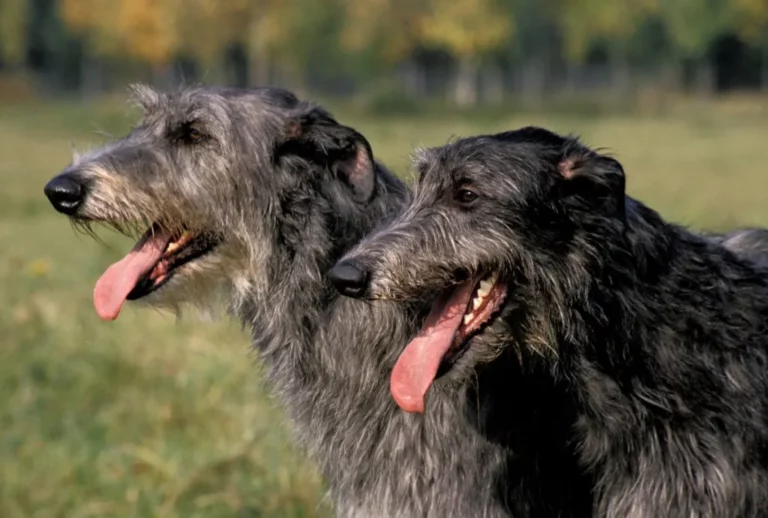Scottish Deerhound Dog Breed Information
The Scottish Deerhound stands tall and proud in the world of dog breeds. Known for their gentle nature and regal looks, they were initially bred to chase deer in the rough terrain of Scotland’s highlands. These hounds have a striking appearance, with shaggy coats and a large build, and they bring a sense of nobility wherever they go. They’re not just good-looking; they’re also loving and calm companions.
Owning a Scottish Deerhound comes with its duties due to their size and energy levels. They need plenty of exercise and have specific health needs that can’t be ignored. If you’re thinking about bringing a Deerhound into your home, it’s essential to understand the commitment you’re making.
Living with a Deerhound offers a unique experience, but being prepared for their care requirements is essential.
The Scottish Deerhound is a majestic, gentle breed. They are known for their shaggy coats and stature and are bred for hunting. Owning one means embracing exercise and health care.
Key Takeaways
- Deerhounds exude calmness and companionship.
- Their exercise needs are significant due to size.
- Health care is a priority for this breed.
Scottish Deerhounds are affectionate giants from Scotland’s past. These dogs need regular activity to stay fit and happy. A commitment to their well-being is essential for owners.
Quick Facts
The Scottish Deerhound, known for its gentle nature and stature, is the tallest among sighthounds. Male Deerhounds typically stand between 30 and 32 inches tall, while females are generally over 28 inches tall. Their impressive height was bred for the challenging task of hunting deer on Scotland’s rough terrain. Often referred to as the Scotch greyhound or Highland deerhound, this dog is part of the Hound group and is cherished for its kind temperament, loyalty, and strong hunting instincts.
As one of the most giant dog breeds, the Scottish Deerhound is outmatched in height only by the Irish Wolfhound. Its coat is a notable characteristic, being rough and bristly, which helps shield the dog from inclement weather, especially around its chest and abdomen. The coat, which commonly comes in shades of gray, needs regular grooming to stay tangles-free.
Scottish Deerhounds have an average lifespan of 8 to 11 years but are prone to specific health issues that require attentive care from their owners and veterinarians. Celebrated by Sir Walter Scott, the breed gained fame in literature as the ‘rough greyhound,’ a dog not of noble birth but valued for its elegance and speed.
Scottish Deerhound Dog Breed Pictures
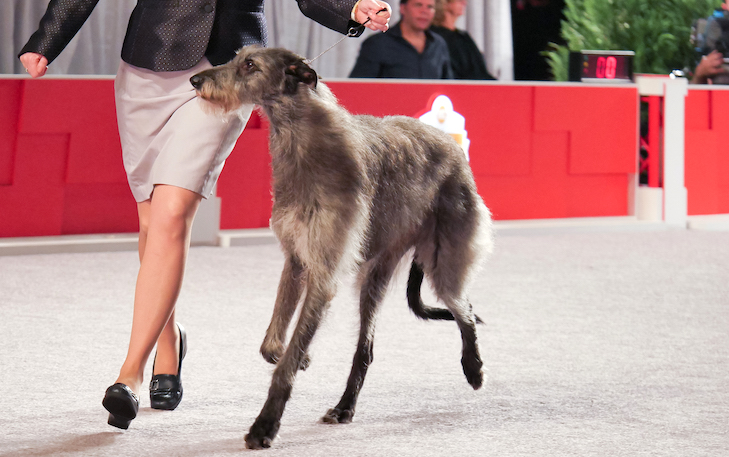
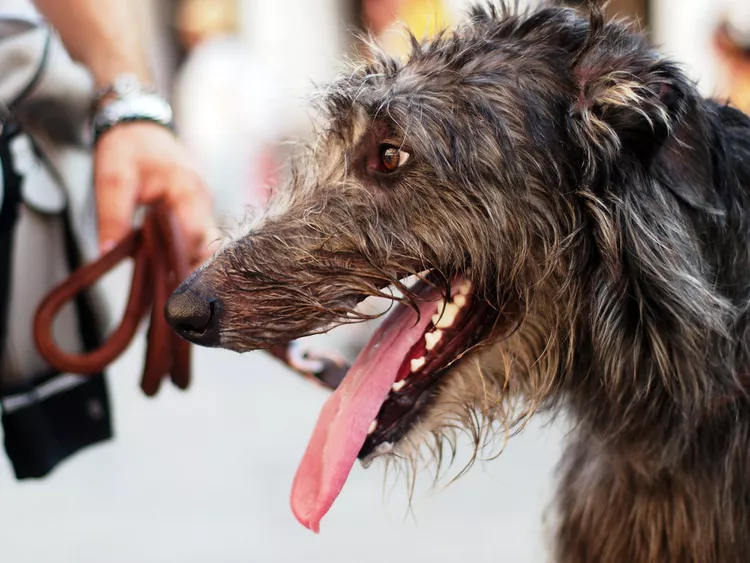
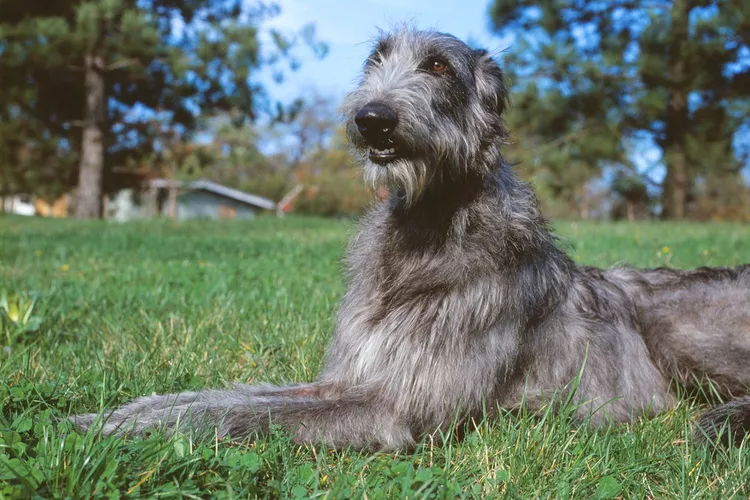

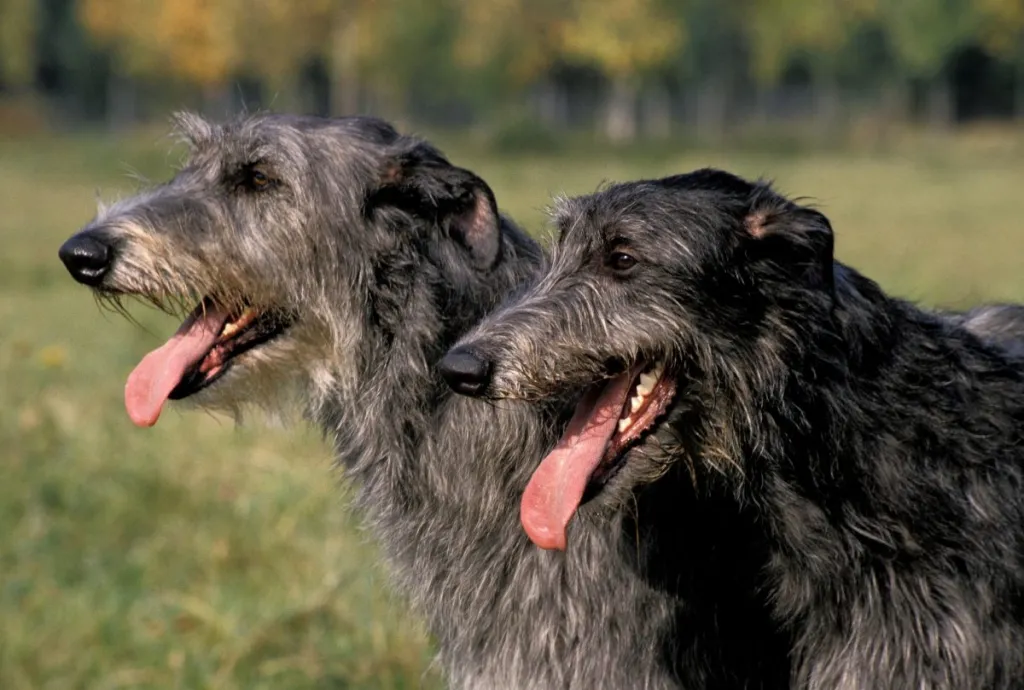
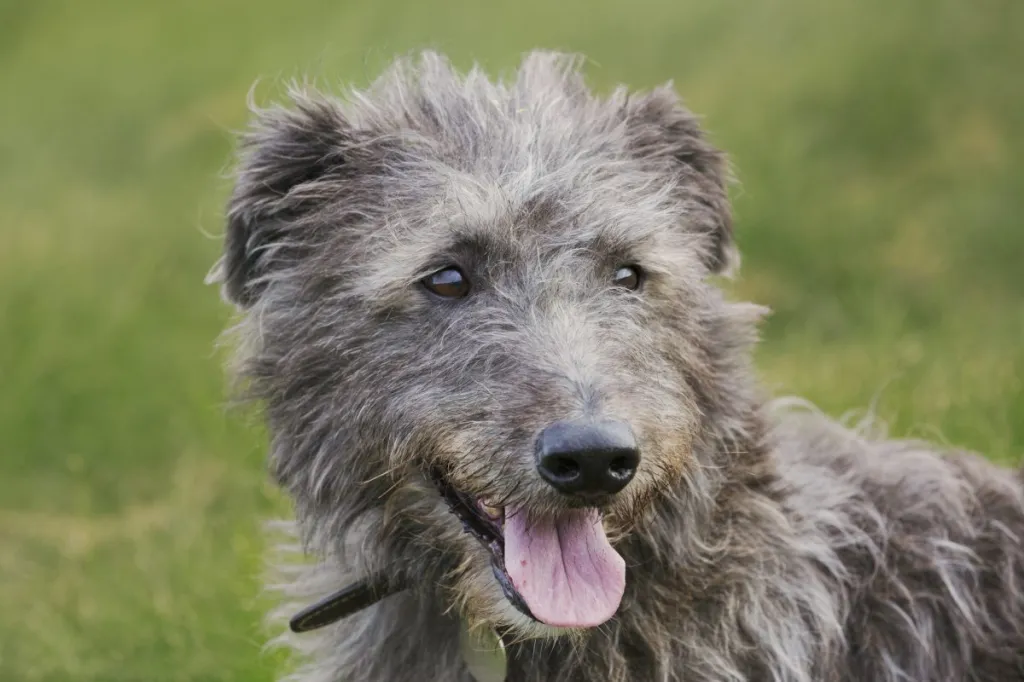
Overview of Deerhounds
The majestic Scottish Deerhound, bred explicitly for tracking deer, symbolizes Scotland’s rich hunting heritage. This tall and slender breed is built for speed and stamina, necessary for navigating the challenging Scottish landscapes during hunts. Its body shape, with a deep chest and a streamlined tail, allows for impressive agility and endurance, which were crucial for chasing deer.
Despite the Scottish Deerhound’s friendly nature, its strong hunting instincts mean it must be well-socialized, especially around smaller pets. Owners of this large breed need to provide regular exercise to keep their dogs healthy while being vigilant for signs of bloat, a deadly condition where the stomach twists and requires immediate vet care.
Known for heart issues like cardiomyopathy, regular vet checks are vital for the Scottish Deerhound. The Scottish Deerhound Club of America promotes responsible breeding and health monitoring to ensure these noble dogs live healthily. Owners should follow tailored healthcare advice to protect the welfare of these impressive dogs.
Gentle Giant Traits
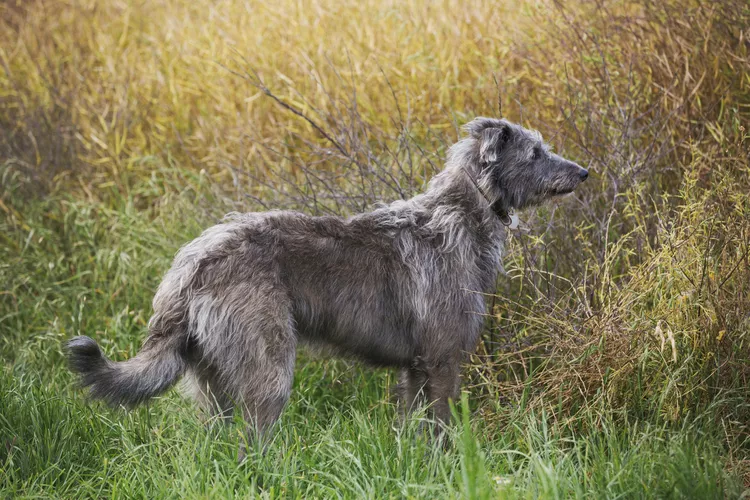
Scottish Deerhounds are the epitome of a gentle giant, blending their impressive size with a friendly and loving nature. They offer a beautiful mix of majesty and softness, with their tall, slender builds and dignified presence complemented by a kind-hearted character. These dogs are calm and faithful, making them perfect for family life.
The breed’s characteristics stem from a history of careful breeding for both looks and behavior. This has produced a visually stunning dog with natural behavioral tendencies. The table below outlines the main features of the Scottish Deerhound’s gentle giant persona:
| Trait | Description |
|---|---|
| Disposition | Shows a peaceful and friendly personality, making them great for family life. |
| Loyalty | Displays a deep bond and emotional attachment with their owners. |
| Prey Drive | Has a strong instinct to chase, so they need a secure area to play in. |
| Exercise | Needs plenty of physical activity to stay healthy and balanced. |
| Stature | Looks noble and elegant, which is enhanced by their gentle nature. |
Meeting their exercise needs and managing their strong hunting instincts is essential when caring for these dogs. At the same time, their desire for love and companionship must be fulfilled. The Scottish Deerhound is a remarkable blend of a powerful physique and a tender, friendly heart.
Ancient Hunting Origins: Scottish Deerhounds
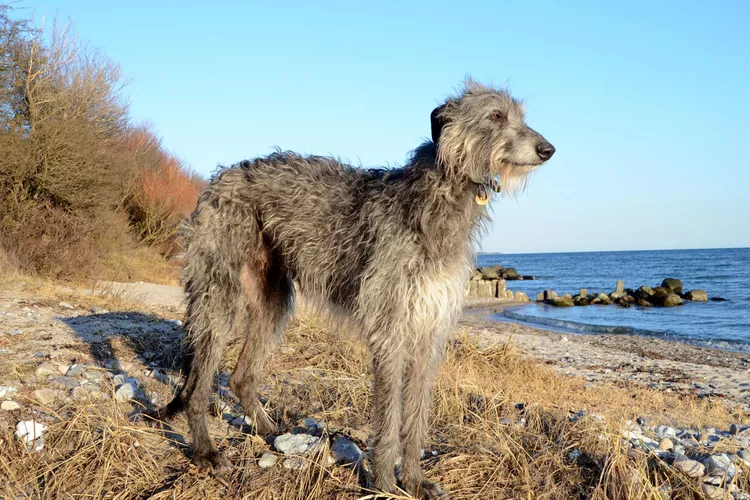
The Scottish Deerhound is a breed that has been shaped over time for the rigors of hunting large animals. These dogs played a vital role in people’s survival and recreational activities in the past. As a type of sighthound, the Deerhound has evolved to have a body built for endurance, speed, and an innate ability to spot and chase down prey. Their role in hunting, especially in chasing deer, has influenced their physical and instinctual traits.
- The Deerhound’s body is built for chasing over long distances.
- They have a natural knack for sharp sensory perception.
- They hold an esteemed place in the history of aristocratic hunting.
- The breed has adapted to be flexible in a range of hunting scenarios.
The Scottish Deerhound’s anatomy is streamlined for sustained chases, allowing them to excel in pursuing game over vast expanses. Their senses are finely honed, making them excellent at detecting animals from afar. These hounds have a storied past as favored companions among the nobility for their hunting prowess. They’ve also proven to be adaptable hunters, capable of tackling various environments and conditions. This versatility has made them enduring figures in the hunting dog legacy.
Breed’s Hunting Heritage
The Scottish Deerhound comes from a rich history, having been carefully crafted for hunting red deer. Their breeding focused on stamina and speed to excel in the demanding tasks of chasing and catching prey. They were highly valued by the aristocracy for their skill in hunting, even capable of taking down wolves, showcasing their adaptability in different hunting scenarios. These dogs were crucial players in Scotland’s historical hunting scenes. The Scottish Deerhound has maintained impressive hunting abilities through years of selective breeding course.
These hounds were not just pets but vital companions in the hunt, prized for their effectiveness in the Scottish Highlands. Their legacy continues today, and while they may not chase deer as often, their physical and instinctual traits remain. They embody the tradition of hunting with dogs, a practice that has been refined over countless generations.
Deerhound Ancestral Roles
The Scottish Highlands are known for their rugged beauty, and the Scottish Deerhound is a breed deeply rooted in this region’s history. These large dogs were bred for their extraordinary capacity to hunt and bring down game such as red deer. Known also as the Scotch Greyhound, they became indispensable to landowners and nobility for their hunting skills.
The Deerhound may shaped by its history of tracking and capturing large animals. Their speed and agility were perfect for pursuing deer, wolves, and wild boars. These dogs were fast and had the stamina to chase prey long distances. Their natural hunting instincts made them highly valued by those who needed a capable hunter.
The Deerhound’s reputation grew as they proved to be as effective as the Greyhound in the hunt.
Evolution of Hunting Practices
Early human societies relied on hunting for survival, using simple tools like stone-tipped spears, bows, and traps. As farming and the taming of animals began, the need to hunt for food decreased.
As societies grew more complex, hunting symbolized power, status, and leisure. Different cultures developed their unique hunting traditions, reflecting the diversity of environments and species around them.
Hunting has been a critical survival strategy for early humans, evolving from necessity to a symbol of social standing over time. Today, the practice reflects a rich mosaic of cultural traditions shaped by the demands of distinct ecosystems.
Large Stature
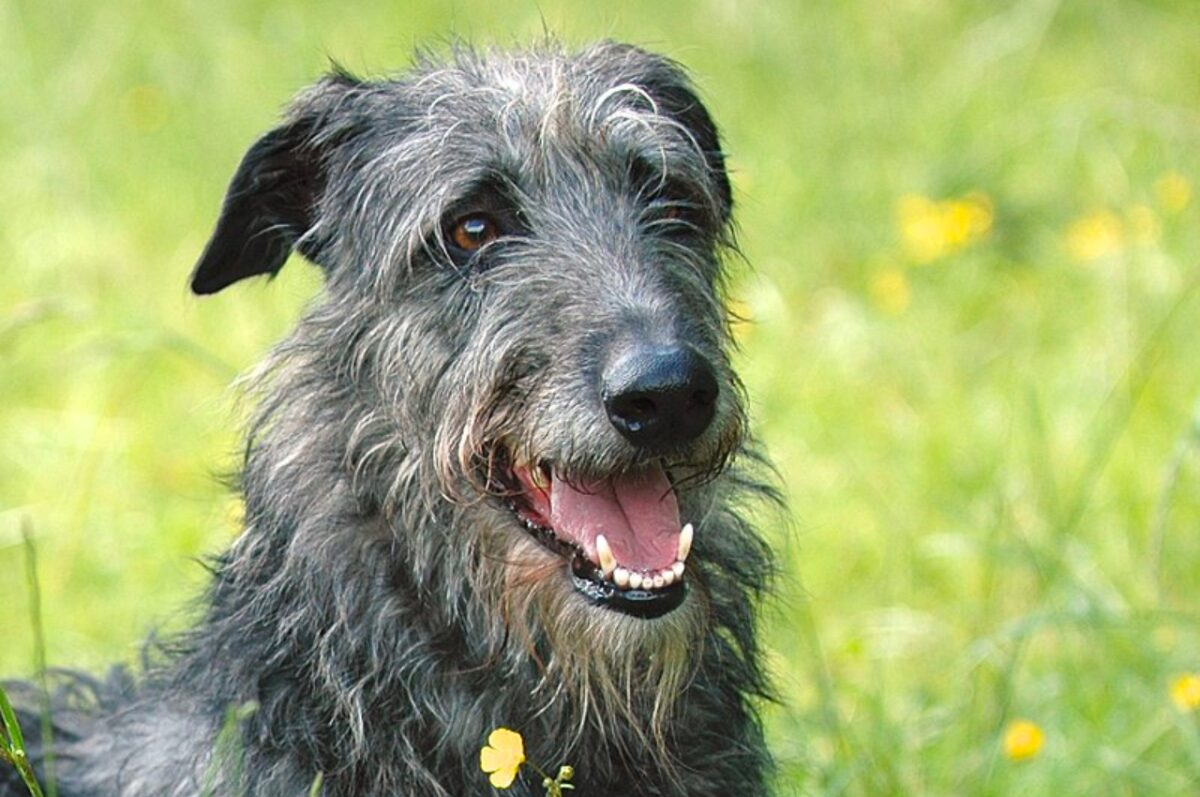
The Scottish Deerhound stands out for its impressive size, an essential trait for its traditional role in hunting. The big frame of this breed calls for careful health management and ensuring they have enough room to live comfortably. They typically grow very tall and heavy, so they need plenty of space to keep their bones and muscles healthy.
Proper nutrition is vital for these dogs to grow well and stay healthy. Watching their weight to avoid extra strain on their heart and joints is essential. They also need a lot of exercise to keep fit and prevent joint issues.
Despite their size, Scottish Deerhounds are gentle and need regular interaction with people and other dogs to stay happy. Without it, they might get anxious and develop unwanted behaviors.
Impressive Height Range
Male Scottish Deerhounds stand tall at 30 to 32 inches, while females reach over 28 inches. They carry a weight that matches their large size, with males ranging from 85 to 110 pounds and females weighing in at 75 to 95 pounds.
These giant dogs have a history of excelling in hunting activities due to their size and strength. They thrive in environments with plenty of room to move around, which suits their hunting heritage.
To keep a Scottish Deerhound healthy, it’s vital to have regular vet check-ups and follow a strict diet plan. This ensures their muscles and bones stay strong and healthy.
Weight Considerations
Proper weight management is crucial for the health of Scottish Deerhounds. These large dogs need careful monitoring to avoid health issues. Male deerhounds weigh anywhere from 75 to 110 pounds, while females can weigh between 75 and 95 pounds. Their size requires them to have enough room to exercise and avoid becoming overweight. Being overweight can lead to joint problems like osteoarthritis.
A diet that meets their specific energy needs is vital for these dogs. Regular check-ups with a vet can catch weight-related problems early on. Good breeding practices can also help minimize genetic issues that could cause weight gain.
Regarding training, it’s essential to focus on their natural hunting instincts. This ensures they can be safe around smaller animals.
Space Requirements
Scottish Deerhounds require plenty of space for daily exercise to stay healthy and well-behaved. These large dogs need a big, secure area to run and play to burn off their energy. Owners should get at least two hours of physical activity daily to keep them in good shape.
A proper fenced yard is crucial to manage their strong hunting instincts and to keep them safe. These dogs may develop negative behaviors and health problems without enough room to move.
Gentle Giant Nature
The Scottish Deerhound impresses with its oversized frame yet wins hearts with its warm and friendly nature. These dogs make excellent family pets, thanks to their calm demeanor and desire to make their owners happy. Despite towering at 30-32 inches for males and weighing 85-110 pounds, with females being a bit shorter and lighter, they move with a grace that belies their size.
Their affectionate personality and loyalty make them great for social settings and family situations.
They need room to roam and exercise due to their instinct to chase. Their impressive size and gentle personality make them protective and cherished additions to any home.
Physical Appearance Traits
Scottish Deerhounds are impressively tall, with males standing at 30-32 inches and females at least 28 inches. Their body is sleek and elongated, a perfect match for their height. The males of this breed are heavier, tipping the scales at 85-110 pounds, while the females are generally lighter, weighing in at 75-95 pounds. This breed shows a clear difference in size between the sexes.
Their wiry coat can grow to about 3-4 inches, covering a body built for speed and stamina. These dogs have a look shaped by the need to perform in Scotland’s rugged terrain. Sporting a coat that’s usually gray, Scottish Deerhounds have a regal look that reflects their heritage as skilled hunting dogs.
Docile Demeanor
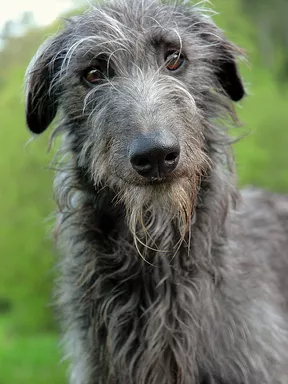
The Scottish Deerhound is well-known for its gentle temperament, making it a perfect fit for home life and bonding with people. Their easygoing attitude means they’re typically not aggressive and love being around others, which makes them great pets for families.
However, to keep them happy and healthy, it’s vital to consider a few things.
When welcoming this breed into your home, it’s vital to socialize them properly due to their mellow nature. Making sure they feel part of the family will help them thrive. Exercising them regularly is crucial to prevent laziness stemming from their relaxed demeanor.
Solid training from a young age is valuable to make the most of their willingness to cooperate. Lastly, their calming effect can be incredibly beneficial in settings like therapy work, where they can provide comfort and support.
Gentle Giant Nature
Scottish Deerhounds are known for their calm and friendly personality, often described as the canine version of a ‘gentle giant.’ They are incredibly lovable and easygoing, making them great companions for families and single owners.
They’re usually relaxed in the home, but it’s wise to watch them around small kids because they are so large. While they may be laid-back, these dogs still strongly desire to run and need plenty of exercise to stay happy and healthy.
Keeping them in good shape also involves regular vet check-ups and a diet that is right for their breed, as they can be prone to specific health issues. A healthy balance of love, care, and activity is critical for these majestic dogs.
Family-Friendly Traits
Scottish Deerhounds are known for their calm nature, making them great family companions. Historically, they’re gentle giants, making them a favorite in Scottish royal circles. These dogs are easy to get along with and fit into many different home settings.
They are especially good with kids and can live peacefully with other pets if properly introduced. Their laid-back personality also suits older family members, offering calm friendship without the over-exuberance of more energetic dogs. Scottish Deerhounds are loyal and protective, making them reliable household members.
Indoor Behavior Tendencies
Known for their calm and friendly nature, Scottish Deerhounds are perfect for peaceful indoor environments. They have a very relaxed and pleasant attitude, making them great companions at home. These dogs love to lounge and often seek calm spots to rest for long periods. It’s essential to balance their love of relaxation with enough exercise to keep them healthy and prevent weight gain, a risk for less active dogs. When it comes to training, they’re eager to please and learn quickly, which helps them get along well with their families indoors.
Calm, friendly, and relaxed, Scottish Deerhounds are ideal pets for those who enjoy a quiet home life. They tend to be very easygoing and integrate seamlessly into a household’s daily rhythm. Regular physical activity is vital in keeping these dogs in good shape; it wards off health issues tied to inactivity, such as obesity. Their willingness to learn makes training smooth, fostering a peaceful coexistence with their owners.
Training Response Peculiarities
The Scottish Deerhound’s calm disposition is excellent for a peaceful home, but it’s crucial to train them in a way that keeps them attentive and obedient. Their willingness to please is a significant advantage during training. But because they’re so relaxed, they need clear and steady guidance to prevent them from making their own rules.
These dogs are intelligent but can lose focus quickly, so keep training sessions exciting and diverse. It’s also essential to socialize them well. With their friendly nature, they can get along with kids and adults. But always watch them closely because they’re big and strong, and you want to avoid accidents.
Scottish Deerhound training must be consistent and engaging to work well. They have a friendly nature that must be nurtured with good social skills. Thanks to their size and power, this helps them get along with everyone safely.
Calming Presence Benefits
The Scottish Deerhound is known for its calm nature, bringing peace to any home. These dogs are gentle and easygoing, helping to reduce stress and improve the mental health of those around them. The soothing effect of a Scottish Deerhound goes a long way in creating a peaceful home environment.
They are eager to please and are great at getting along with family members, which helps to maintain a calm atmosphere.
With their loyal and laid-back temperament, Scottish Deerhounds make for a subtle but reassuring presence in the home. They are protective without being overbearing, offering security to help everyone feel more relaxed and emotionally balanced.
Breed-Specific Ailments
Scottish Deerhounds have a distinct health profile that requires careful monitoring. These large dogs must stay ahead of specific health issues they’re prone to. Pet owners and vets can work together to help these noble animals enjoy a whole and healthy life.
Heart health is a significant concern for Scottish Deerhounds, with dilated cardiomyopathy being common. It’s wise to schedule heart checks regularly to catch any problems early.
Bone cancer, known as osteosarcoma, is also a risk; quick action at the first sign of bone pain or swelling can be life-saving.
To prevent gastric bloat and torsion, which are severe conditions, owners should manage their dogs’ diet and know the warning signs.
Early detection of health issues is critical for a breed with a shorter lifespan. Regular health screenings tailored to Scottish Deerhounds can catch illnesses before they become serious problems.
Common Health Conditions
Scottish Deerhounds often face serious health issues like cardiomyopathy and osteosarcoma, which need close attention and swift treatment from a vet. Dilated cardiomyopathy is especially dangerous as it weakens the heart muscle, potentially leading to heart failure. Osteosarcoma is a severe type of bone cancer that causes pain and limping in the legs and may need intense treatments, including removing the affected limb and following up with chemotherapy.
Another urgent health problem is gastric dilatation-volvulus (GDV), also known as bloat, which can quickly become deadly if not treated surgically right away.
Thanks to modern advances in animal health care, vets can diagnose and treat these conditions better, helping Deerhounds live longer, healthier lives.
Lifespan Considerations
Awareness of the Scottish Deerhound’s genetic health risks is essential for prolonging their 8-11-year average lifespan and improving their overall well-being. Owners need to be on the lookout for cardiomyopathy, which is the weakening of the heart muscle, and osteosarcoma, a severe form of bone cancer. Preventative steps to guard against gastric dilatation-volvulus, also known as bloat, are crucial; this is a rapid onset condition that can cause a dog’s stomach to expand and twist, often requiring emergency veterinary care.
Scheduling routine health checks, practicing selective breeding to avoid passing on these issues, and providing a balanced diet coupled with regular physical activity and mental stimulation are vital. These efforts help reduce the impact of health problems specific to the breed and promote a longer, happier life for the Scottish Deerhound.
Preventive Medical Care
Routine health checks are essential for identifying and managing common health issues in Scottish Deerhounds, such as heart disease, bone cancer, and stomach bloat. Following recommended health screening guidelines from the American Kennel Club (AKC) is vital for responsible dog breeding and reducing the spread of inherited diseases.
A proactive health plan should include a nutritious diet and regular exercise to maintain strong bones and muscles and prevent gastric dilatation-volvulus. Paying close attention to symptoms of joint and heart problems allows for quick action and better health outcomes.
Staying informed about the latest veterinary research helps to ensure Scottish Deerhounds receive the best preventive care for a healthier, longer life.
Regular vet exams are crucial for Scottish Deerhounds to catch and treat breed-specific issues early. Adhering to American Kennel Club health screening recommendations is essential for breeding responsibly and preventing genetic diseases. A preventative health strategy, including a proper diet and exercise, helps maintain bone and muscle health and reduce the risk of stomach twists. Promptly detecting signs of joint or heart conditions can lead to more effective treatments.
Keeping up-to-date with veterinary science means Scottish Deerhounds get the most current and effective care.
Maintenance Requirements
Caring for a Scottish Deerhound involves specific routines to keep them healthy and happy. Given their athletic nature and large size, these dogs need good exercise and proper coat care. They also require training that matches their intelligent and friendly nature and a diet tailored to their needs.
Exercise is crucial for the Scottish Deerhound to maintain a healthy heart and strong muscles. Daily walks or runs are necessary to meet their physical activity needs.
Regular brushing and occasional baths are vital to keeping their coat in top condition for grooming.
During training, sessions should be consistent and engaging to hold their interest.
Finally, proactive health care is essential. Keep an eye out for symptoms of common ailments in the breed and stay on top of preventive care.
Exercise Needs
Scottish Deerhounds need plenty of exercise to stay healthy and happy. They should have daily time in large spaces to run and play, which keeps their energy levels balanced. These dogs thrive on at least two hours of active exercise daily, which is crucial for their well-being. Without enough physical activity, they may develop unwanted behaviors from lack of stimulation.
These hounds are from a breed known for their strong hunting instincts. It’s essential to introduce them to smaller animals early on and keep them on a leash during walks to prevent chasing. Regular and structured exercise helps Scottish Deerhounds manage their instincts and live well in a home environment.
Grooming Essentials
Regular exercise and a steady grooming routine are essential for your Scottish Deerhound’s well-being. Brush and bathe them often to keep their distinctive coat in top shape and their skin healthy. This helps prevent tangles and supports the natural shedding of hair and skin. Their coat’s texture means they don’t need baths too often, which helps keep their skin’s protective oils.
Trimming their nails is essential to avoid any changes in their walk, which could lead to joint issues. Keep an eye on their ears, cleaning them periodically to prevent infections.
These steps will help prevent skin problems and improve your dog’s health.
Training Strategies
Training Scottish Deerhounds requires a consistent approach that also allows for flexibility. Using positive reinforcement is crucial in guiding their independent nature. Rewarding good behavior with treats and praise helps to shape their actions positively.
Keeping their minds active with different activities prevents boredom and keeps them engaged. It’s essential to regularly reinforce commands and rules to ensure they understand and follow them.
Due to their strong hunting instincts, training for impulse control around smaller animals is essential. Regular, structured training sessions help maintain their obedience and contribute to their overall well-being.
Health Considerations
Caring for Scottish Deerhounds involves a dedicated approach to their health and training. It’s essential to keep up with routine vet check-ups to spot issues like heart disease and bone cancer, which are common in this breed standard. Good breeder can help reduce the risk of these health problems.
Awareness and quick action are crucial to prevent gastric bloat, a deadly condition affecting these dogs. Mental stimulation and regular exercise are vital to keeping Scottish Deerhounds happy and healthy.
Their coat needs weekly brushing and the occasional bath to stay clean and prevent skin problems. These steps are vital to ensure the well-being and longevity of these noble dogs.
Dietary Regimen
Scottish Deerhounds need a well-rounded diet of quality proteins, fats, and carbs. This helps them keep up their size and energy levels. Their food must be proportioned correctly to keep them lean but not overweight, which could lead to joint problems like osteoarthritis. It’s essential to measure their food carefully and adjust their calories based on how much they move around to keep them in good shape.
Staying hydrated is also crucial for these dogs since they can get bloated, which is a severe stomach issue. It is best to work with a vet to create a diet that fits the dog’s unique needs and considers any health issues they might inherit. A personalized diet helps keep a Scottish Deerhound healthy all around.
Dietary Regimen
The health and performance of a Scottish Deerhound are closely linked to their diet. A well-balanced intake of large and small nutrients is critical to meet their high-energy needs, especially since they are naturally active dogs. Experts recommend customized nutrition plans to suit the dog’s requirements, which vary with age, size, and daily activity levels.
Calorie intake should be carefully calculated to keep the dog in peak physical shape. Deciding the correct times to feed your Deerhound can promote better digestion and energy use. Providing them with high-quality dog food rich in omega fatty acids and lean proteins is advisable to support their overall health. It’s also important to watch for any adverse reactions to certain foods and make diet adjustments as necessary.
Nutritional Needs
Protein and fat are essential for Scottish Deerhounds’ diet to support muscle and energy levels. They must get the right balance of vitamins and minerals to avoid common health problems.
Regular feeding times and portion control help prevent obesity. High-quality carbohydrates provide needed energy.
Consult with a veterinarian to customize your dog’s nutrition.
Feeding Frequency
Feeding Scottish Deerhounds twice daily is essential to support their high-energy needs and reduce the risk of bloat. This regular meal schedule helps keep their metabolism balanced and prevents weight gain, which is necessary because extra pounds can worsen joint problems in these large dogs. A nutrient-dense diet that matches their energy use is critical for the health of this active breed.
Regular check-ups with a vet are essential to ensure the diet is proper for your dog, taking into account their health and any potential breed-related dietary issues. Consistent feeding times help maintain their overall health and play a crucial role in maintaining digestive health. This is especially important for large breeds like the Scottish Deerhound, which are at risk of severe conditions like bloat.
Recommended Food Types
For Scottish Deerhounds, choosing a diet that supports their unique needs is essential. High-quality proteins like beef, lamb, or fish are crucial for maintaining muscle health. These sources are packed with vital amino acids that help maintain muscle growth. It’s also important to include complex carbs such as sweet potatoes and a variety of vegetables. These provide sustained energy and keep their digestive systems running smoothly.
Keeping an eye on how much food they eat is critical to preventing weight gain. Smaller, measured meals are the way to go. Their diets should also include omega-3 fatty acids from sources like fish oil, which are great for joint health and can help with osteoarthritis concerns. Adding glucosamine can further strengthen their joints.
Probiotics are an excellent addition to their diet for a healthy gut and immune system, contributing to a shiny coat and healthy skin.

